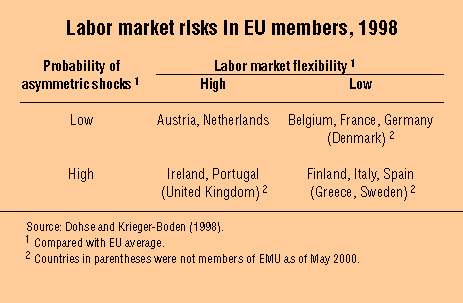 About F&D Subscribe Back Issues Write Us Copyright Information Use the free Adobe Acrobat Reader to view a pdf file of this article
|
European Labor Markets and EMU Challenges Ahead Rüdiger Soltwedel, Dirk Dohse, and Christiane Krieger-Boden The debate about European Economic and Monetary Union (EMU) has so far been dominated by questions of fiscal convergence and macroeconomic stability. Far less attention has been given to EMU's effects on labor markets, although labor market performance will be crucial in determining the long-term success or failure of EMU. Currency unions like EMU have certain undisputed benefits. They reduce the costs for foreign exchange and hedging transactions and heat up competition in goods and factor markets, which stimulates trade, investment, growth, and employment. However, the members of currency unions must also relinquish two important policy instruments for responding to economic shocks: an independent monetary policy and currency devaluation. When these tools are unavailable, asymmetric shocks—shocks that affect some countries or regions in a currency union but not others—put pressure on national labor markets and may boost unemployment rates in affected areas. The exchange rates between the currencies of European Union (EU) member states played an important role as shock absorbers before the establishment of EMU on January 1, 1999. EU members hit by asymmetric shocks responded by adjusting prices (particularly the nominal exchange rate) rather than by adjusting output. The incidence of asymmetric shocks has been higher for Finland, Greece, Ireland, Italy, Portugal, Spain, Sweden, and the United Kingdom than for Austria, Denmark, France, Germany, and the Benelux countries. Among the EU members prone to asymmetric shocks, Finland, Italy, and Spain also have inflexible labor markets and are therefore the countries most likely to experience rising unemployment as they adjust to shocks (see table). From a labor market point of view, Austria and the Netherlands appear to be the EU members best prepared for EMU. Although Ireland, Portugal, and the United Kingdom have high exposure to asymmetric shocks, their labor markets are flexible enough to absorb shocks without huge increases in unemployment. In contrast, Belgium, Denmark, France, and Germany would probably see greater structural unemployment in response to shocks, however rare such shocks might be.
|
|

Historic patterns of susceptibility to shocks may not persist in the euro area, one reason being that EMU has eliminated some of the major sources of asymmetric shocks—namely, inconsistent national monetary policies and speculative attacks on national currencies; moreover, EMU members have less scope for implementing destabilizing national fiscal policies. However, even a common monetary policy can be a source of asymmetric shocks. U.S. monetary policy, for example, has generated asymmetric shocks to regions in the United States because of structural differences in regional economies. Hence, the probability of asymmetric shocks depends upon the economic structures—and their development over time—of countries participating in a currency union. The critical question is how EMU will affect these structures and whether business cycles will be synchronized across EMU members. There are two opposing views on this question. One line of reasoning suggests that tighter forward and backward trade linkages between countries in a currency union will make their economic structures and business cycles more similar and shocks more symmetric, particularly if demand or other common shocks predominate, or if trade is concentrated within a given industry (see, for example, Frankel and Rose, 1998). The opposite line of reasoning emphasizes that, in a common currency area, there are better opportunities for the exploitation of economies of scale (for example, via localized knowledge spillovers), encouraging the geographic concentration of industries and making it more likely that a given shock will have asymmetric effects on different regions because of differences in their production structures (see, for example, Krugman, 1993) . On theoretical grounds, both hypotheses are equally plausible, and the empirical evidence is inconclusive. Our estimates suggest that, in most EU countries, regional specialization increased in the early 1980s but decreased in the early 1990s. Hence, policy should take a cautious stance and prepare for potential shocks. A regional perspective In addition to the structural differences between national economies that make some of the EU countries more susceptible to shocks than others, there are marked differences between regions within a number of EU countries. EMU is likely to affect these regions differently. For example, western Germany's Rhineland region, with its geographic proximity to Belgium, France, and the Netherlands, will most probably benefit more from the currency union than eastern Germany's Oberlausitz region, which is adjacent to Poland. Furthermore, the sectoral structure of western Germany's economy is closer to the EU norm than is that of eastern Germany's economy, which suggests that the latter may be more susceptible to asymmetric shocks than the former. The same distinction can be made between the economy of Italy's Mezzogiorno and the more advanced economies of its northern and central regions. In fact, asymmetric shocks in the EU are much more pronounced on a regional than on a national level. Differences between the GDP growth rates of regions in the same country are almost double those between the GDP growth rates of the countries themselves. Europe's unemployment problem also has a marked regional dimension, with unemployment rates in economically troubled regions more than 10 times higher than in the best-performing regions. These regional unemployment disparities have not only been far more persistent in Europe than in the United States but have also become more acute over time: the dispersion of regional unemployment rates across the EU was three times higher in 1995 than in the late 1970s. Unemployment problems are concentrated in countries and regions at the periphery of the EU: Finland, eastern Germany, Ireland, southern Italy, and southern Spain. Labor market stickiness is very pronounced (that is, labor market conditions do not change quickly in response to changes in supply and demand) in these regions, and EMU will probably have a less beneficial impact on them than on other countries or regions, because they engage in relatively little trade with the rest of EMU, profit less from the elimination of exchange rates, and are more prone to asymmetric shocks. The major reason why EMU poses a threat to European labor markets is the high probability of region-specific (asymmetric) shocks, in combination with the lack of functioning adjustment mechanisms at the regional level. Well-functioning regional labor markets are crucial to weathering adverse region-specific shocks. Whereas labor migration plays a substantial role in allowing regions in the United States to adjust to shocks, interregional labor mobility is limited in Europe, leaving regional wage flexibility as the main adjustment mechanism. Empirical studies show, however, that wage policy in Europe is not region-specific: wage setting in prosperous regions spills over to problem regions where productivity growth is slower than in the rest of the economy. Furthermore, labor market institutions such as unemployment benefits, minimum wages, job-protection laws, and regulations governing work hours are shaped, for the most part, at the national level and offer few possibilities for region-specific adjustments to shocks. If there is neither labor mobility nor wage flexibility, there will be either increased interregional transfers or an increase in unemployment (open or disguised) in regions hit by adverse shocks. However, long-run transfers are, in fact, not an adjustment mechanism but a practice that prevents adjustment and structural change. In addition—and not to be underestimated—massive regional transfers have substantial moral hazard effects. Will EMU spur labor market reform? In preparing for monetary union and responding to increasing adjustment pressures, EU members have taken steps in opposite directions. On the one hand, some countries have attempted to stifle competition, a move that might easily lead to a vicious circle. On the other hand, there are indications of a potentially virtuous circle, as several EU member states have implemented, at different speeds and to different degrees, measures to decentralize and deregulate their economies and to increase the flexibility of their labor markets (the Netherlands and the United Kingdom have gone the farthest down this road). The vicious-circle scenario relates to the efforts of politicians, unions, and special interest groups to fend off the adjustment pressures generated by the completion of the single market, the globalization of markets, and the introduction of EMU, and to protect European workers against what they consider to be "unfair" competition and "wage dumping" by imposing minimum standards for working conditions on the basis of the EU's social charter, which was agreed upon by EU member governments in 1989, and its ensuing action program. Because differences in productivity will not disappear overnight, however, adopting uniform minimum standards may lead to rising unemployment in low-productivity countries and regions and increase demand for EU development assistance. Financing these subsidies, though, is likely to restrain the economic dynamics of the prosperous areas. The virtuous-circle scenario builds on the fact that, by joining EMU, countries have subjected themselves to external pressures that are forcing them to adjust and that there is no turning back. Member governments might use the implementation of EMU to cut back on the welfare state and bring incentive structures into line with economic sustainability to foster market dynamics. Burda (1999) even argues that EMU is a "Trojan horse for decentralization." However, there is no room for complacency. The circle will not be virtuous unless countries adopt policies capable of fostering and harnessing the forces of structural reform. As a matter of fact, all EU member countries committed themselves to the comprehensive and consistent labor market reforms that constitute the "job strategy" of the Organization for Economic Cooperation and Development (OECD, 1995), although they have been slow to take action. Because the various elements of labor market flexibility, such as wage flexibility, flexible work hours, and geographic mobility, are—up to a point—substitutes for broader reform, there is no need for all countries to follow the same reform model to attain higher overall labor market flexibility. Country-specific preferences may lead to different approaches to achieving flexibility with broadly similar impacts on labor market efficiency. What is crucial, though, is to take into account the inherent complementarities among broad policy areas affecting the labor market. Institutional and regional diversity The institutional homogeneity prevailing in most EMU countries may lead to a mismatch between institutions and economic conditions in problem regions and jeopardize the efficiency gains expected from the implementation of the monetary union. Given the widely divergent economic and social conditions from country to country as well as within countries, it seems appropriate not only that reform packages be country-specific but also that they take the regional dimension into account. Because of the lack of institutional variety within national employment systems, there is hardly scope for appropriate dynamic reactions to idiosyncratic shocks. To achieve broader regional diversity, opt-out clauses from nationwide regulations may be helpful. More institutional diversity could be brought about by allowing what we call "institutional competition" among the various subnational layers of government. We see institutional competition as a means of shaping such factors as the physical and institutional infrastructure of a region, local taxes, and the responsiveness and flexibility of the local administration in order to attract mobile factors of production. Institutional competition—to borrow a concept central to the free-market theories of Austrian economist Friedrich August von Hayek—may work as a discovery procedure for superior policies and institutional arrangements that spur regional economic growth and increase regional employment.
This article draws on a paper prepared by the authors while Rüdiger Soltwedel was a visiting scholar at the IMF: "EMU Challenges European Labor Markets," IMF Working Paper 99/131 (Washington: International Monetary Fund, 1999). References and suggestions for further reading:
|